
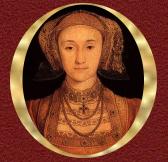
The forth wife of Henry VIII was a German noblewoman and sister to the Duke of Cleves. Her father, John, had been the third Duke of Cleves and the title was passed to Anne's brother when her father passed away. Little is known of her before Henry's courtieres sought to establish a foreign bride for him after the death of Jane Seymour.
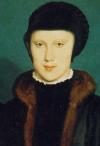
Christina of Denmark
by Hans Holbein
|
|
Henry also began to see that England had been alienated from Catholic Europe after his break from the church and realized the importance of a political match. His succession crisis was also a factor. It had been softened by the birth of Edward but not alleviate altogether. Edward was young, sickly, and the odds of child mortality were higher in those days. Henry sent portraiters to various foreign lands to paint possible matches for him so that he could ponder them in England. One of these was Christina of Denmark, the Duchess of Milan, who replied amusingly to the idea of marriage to Henry that if she had more than one neck, she would surely grant one to the King. Hans Holbein painted a likeness of Christina for the King but she clearly had little desire to be his wife.
|
|
Holbein was also sent to the Duke of Cleves who had two marriable sisters, Anne and Amelia. Cleves had also rejected Papal authority and was seen as a good ally for England. In 1539, Holbein made the journey to Cleves where he painted both Anne and Amelia. Both portraits were sent to the King who chose Anne's likeness to be the fairer of the two. In it she wore a traditional Clevish headdress and red gown. This was quite different from English style but it probably appeared exotic to the King. He arranged for a marriage contract to be drawn up immediatly and Anne began her journey to England.
| |
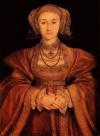
The betrothal portrait
of Anne of Cleves. |
|
|
The journey proved to be long and tiresome including horeseback and sea travel. Anne arrived in Rochester on New Year's Eve where she spent the night in the Abbey. The following day as she was watching a bull-baiting from her window, six men entered her room dressed as commoners. One of the six men embraced her, kissed her and gave her a token from the King as a New Year's present. Anne was taken aback at his forwardness but politely thanked the man and took the gift. She spoke with him for awhile but payed him little more attention than the bull in the courtyard. Noticing her lack of interest, the men left. The King entered the room moments later in a robe of purple velvet and she bowed to him. Henry spoke lovingly toward her but she didn't speak a word of English and had to communicate through one of her servants.
|
|
Henry revealed his true feelings about their first encounter to his courtieres. It was he who was the forward common man, playing a game with his future bride who he felt sure would recognize him as her husband. To Henry's dismay and angerment, she had no idea who he was and ignored him. Henry's feelings were hurt and he told his coutieres that she was ugly, calling her a "Flander's mare" (horse) and that he didn't like her in the least. In all actuality, Anne probably didn't resemble a horse. Holbein was an accurate painter and Anne's portrait makes her out to be one of the fairer of Henry's brides, at least by modern standards. Henry's envoys told him that Amelia was beautiful, but described Anne as "outshining her fair sister as the Sun outshines the Moon." They must have known that it was not in their best interest to lie to the King. It is probably more likely that Henry's pride was deeply hurt and he exagerrated any flaw in her appearence.
| |
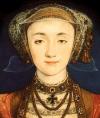
Miniature of Anne
based on Holbein portrait. |
|
|
Despite his anger and dissapointment, Henry honored his marriage contract. To break the engagement and send Anne home in disgrace would have further alienated Lutheran allies in Europe. Having no knowledge of the King's true feelings, Anne married Henry on January 26th 1540 at Greenwich. The wedding night would prove even greater dissapointment to Henry. He refused to consumate the marriage after he saw her naked and accused her of not being a virgin to his courtieres.
|
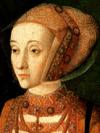
Portrait of Anne
by Barthel Bruyn
|
|
Anne was also poorly suited for life at English court. She recieved little education at Cleves and was more skilled at needlework than playing the lute, which Henry enjoyed so much in Anne Boleyn. Her inability to speak English or Latin also disabled her. Her unitelligence was aparent in her belief that she was not a virgin, simply based on the fact that the King kissed her every night before he went to sleep. No one had educated her on intercourse and when told by one of her ladies what it was, she was shocked and said that she had never been with the King in that way. This fact filled the mouths of court gossips.
|
|
Henry quickly became more and more unhappy with his new wife and attempted methods to make her feel the same in the hopes of a divorse. All of these attempts seemed to backfire on the King. He replaced all of her Clevish ladies with English ladies, but Anne quickly made friends with them and enjoyed their company. He demanded that she only speak English but she learned the language quickly and enjoyed being able to carry on conversations with her ladies and husband. He required her only to wear English clothes, but she happily gave up her awkward and misfitting German style. She bought a whole new wardrobe of English gowns at Henry's expense. The King was beside himself. The alliance with Cleves was no longer so favorable and to make matters worse, one of Anne's younger ladies had caught his eye and he wished to marry her.
|
|
Catherine Howard was a cousin of the Boleyn's and was placed in Henry's court by her ambitious father, the Duke of Norfolk. After only a few months of marriage to Anne, Henry was seeking ways to make Catherine his Queen. Since his instigation tactics didn't work, Henry looked for a more solid excuse to annull the marriage. He tried to establish that Anne's former engagement to the son of the Duke of Lorraine had not been legally called off. In actuality, every precaution had been taken to ensure the legality of the cancellation. By this time, Anne had been approached by Thomas Cranmer who told her of the King's intentions. She surprisingly agreed to the annullment on the conditions that she would be given adequate housing, be provided for, and could still remain in contact with the King's children who she had become very attached to. Henry had stipulations of his own. Anne was to proclaim that her prior engagement to the Dukes son was not legally called off and therefore their marriage was invalid. She was also not permitted to use the title of Queen and would be given the honrable title of the King's sister. Anne and Henry's marriage was declared invalid in July of 1540.
| |
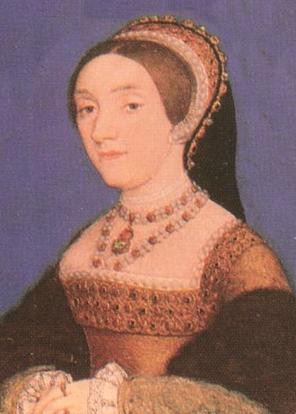
Catherine Howard |
|
|
Anne got more out of her marriage to Henry than most of his wives. She was well provided for until her death in 1557. She became a favorite visitor of Henry at court and maintained relationships with the King's children. Anne attended the coronation of Queen Mary I and walked with Elizabeth in the coronation procession. But it was away from the pressures of courtly life that Anne flourished. She spent more time on domestic tasks that she was brought up with and loved. She also founded a school for orphans. Anne of Cleves outlived the King by 10 years, and all of his wives besides.
|

Anne's signature.


Back to The Six Wives of Henry VIII
|